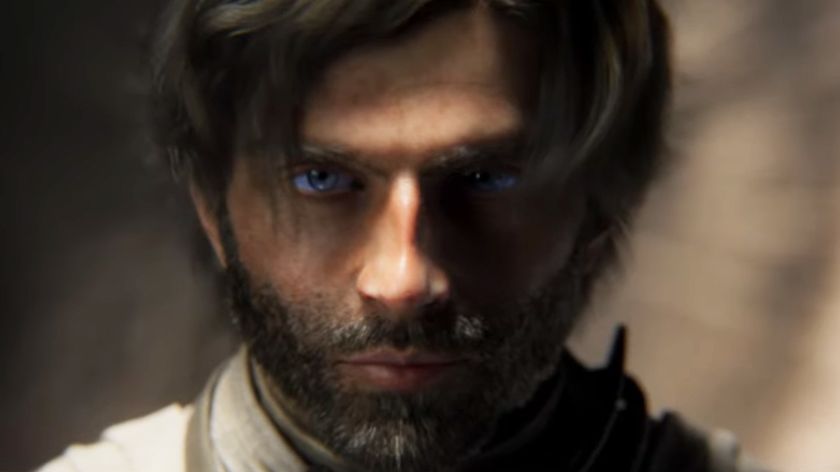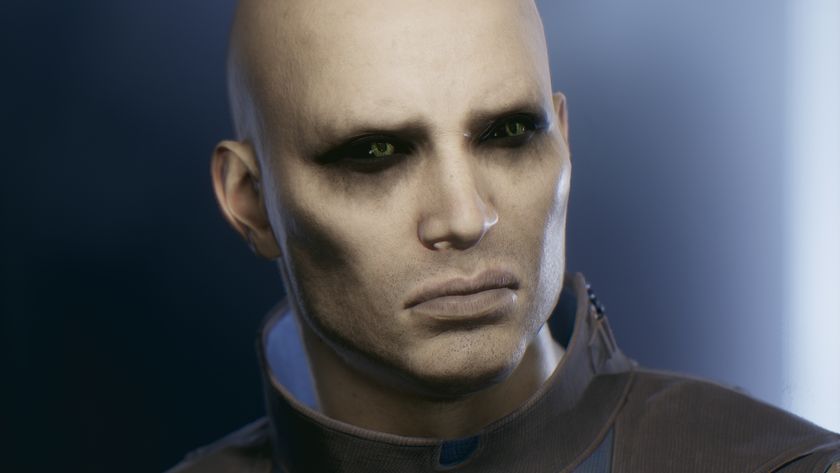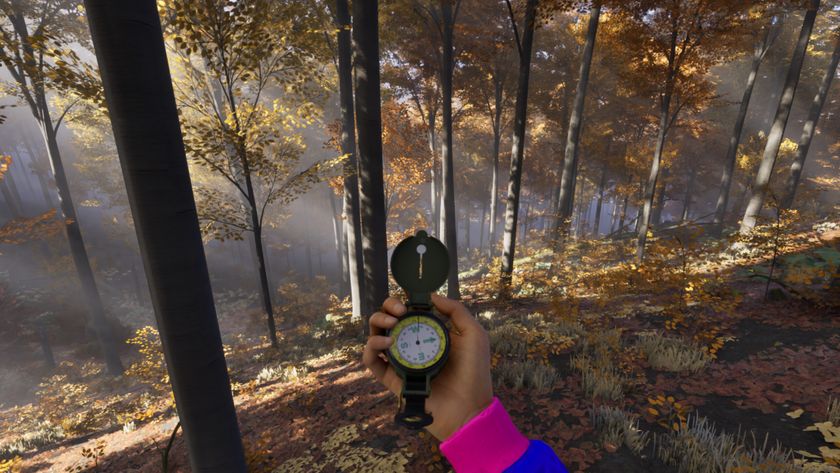Crowfall preview: an MMO you can win, again and again
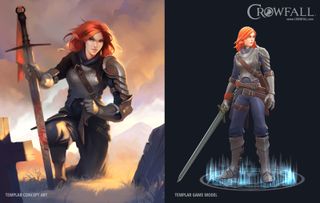
The big idea behind Crowfall is something typically antithetical to MMO design: victory. In most MMOs—say, PlanetSide 2—you keep fighting on and on forever, or at least until the servers shutter one day. But by embracing impermanence, Crowfall’s PvP battles will end, and there will be winners. And when they're over, they'll start all over again on new worlds.
The MMO (which is on Kickstarter as of today) is being designed by ArtCraft Entertainment, a studio founded by J. Todd Coleman and Gordon Walton, whose collective credits (among others) include Ultima Online, Shadowbane, Star Wars: Galaxies, and Star Wars: The Old Republic. So, they know something about MMOs, and my interest was also piqued by the person who brought them to my attention. In 2012, long-time games industry PR professional David Swofford brought Chris Roberts by the office to show me a prototype of Star Citizen, and then in 2013 he showed up with Richard “Lord British” Garriott and Shroud of the Avatar. So when he arrived last week with Coleman and Walton, I expected to see something interesting.
There’s really more to hear than see, though. On Walton’s hefty gaming laptop, Coleman shows me a prototype of Crowfall, and I can mostly only say that I like the art style, which he describes as “a Dota 2-style take on a Game of Thrones universe” and “like high-quality resin toys.” The knight he's controlling looks strong, heavy, and nicely stylized as he demonstrates the physics system by bashing skeletons around. So, I get the gist: this is a good-looking fantasy MMO in a fantasy MMO world.
But that's just my impression of a character wandering alone in a prototype, and hardly the most interesting thing I can say about Crowfall. We spend most of our time talking about what Crowfall will be, and it feels a lot like the first time Roberts showed me Star Citizen: I saw some neat-looking spaceships, but the bulk of the pitch was this big, ethereal cloud of exciting possibilities.
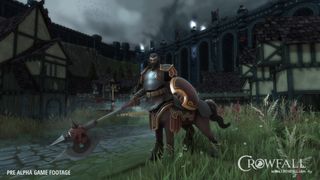
Dying worlds
Off to imagination-land then, where Coleman tells me that Crowfall’s design comes from a problem he identified in Shadowbane, which he worked on back at Wolfpack Studios.
“What would happen with Shadowbane, and is actually typical of strategy games, is that over time, somebody wins,” says Coleman. “And once somebody’s won, the game’s not fun anymore. New people that come in get crushed instantly, old people that come back can’t get a leg up, and so you’ve got the one guy or group who’s sitting on top of the world, and they basically—human nature—they crush everybody new that comes in until people stop coming in, and then they get bored and they leave too.”
Once somebody’s won, the game’s not fun anymore.
The solution, says Coleman, is “eternal heroes, dying worlds.” Crowfall will include permanent home worlds—sort of building, socializing, PvE lands—but the big rewards will be earned by joining campaigns on fresh, procedurally-generated continents and battling for victory. And when one of these campaigns is over (there will be multiple types and win conditions), it’s over and done. The pocked landscape—which will be buildable and destructible through Voxel Tree tech—will be retired, the winners will reap their rewards, and everyone will set out on the next adventure.
The biggest gaming news, reviews and hardware deals
Keep up to date with the most important stories and the best deals, as picked by the PC Gamer team.
There will be lots of campaigns running at the same time, and multiple campaign rulesets (such as the Bloodstone campaign I describe below). At the highest level, campaigns will be grouped by team structure. Faction campaigns will pit the three factions, Order, Balance, and Chaos, against each other, while another campaign type will divide players into 12 teams by their deity of choice, and guild-based campaigns will allow players to self-organize. We also discussed the Dregs, where dangerous free-for-all campaigns will be housed.
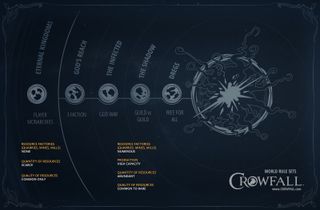
Unlike the faction warfare of games like Dark Age of Camelot or PlanetSide, which Coleman describes as “tug-of-wars,” each campaign will have a clear victory condition. One campaign might last three months, and the winning team is whichever holds the most territory at the end. Another might have no time limit, ending only when one team has amassed enough “Victory Points” through some action defined by the ruleset.
The Bloodstone ruleset
Coleman and Walton offered me the first (subject to change) details on one of these rulesets in the form of a comprehensive FAQ, which I’ll share the main points of here. This hypothetical campaign is a faction-based campaign, so the teams are Order, Balance, and Chaos. It lasts three months, and both Order and Chaos are fighting to amass the most Victory Points (VPs) before it ends, while Balance seeks to end the campaign with Order and Chaos having as close to an even number of VPs as possible.
In the Bloodstone ruleset, VPs are acquired by escorting Bloodstones to their randomized target destinations and sacrificing them to the Gods. Bloodstones are created by Bloodstone trees (of course they are), which, once planted, cannot be moved—but they can be destroyed. Each tree has a cycle timer which triggers protected and unprotected states. During the protected state, the tree and any defenses built around it are safe, but when the tree is unprotected the fortress and tree can be sieged and destroyed. It’s during this unprotected period that the tree spawns Bloodstones, which immediately begin to decay. So, in the midst of a vulnerability, the most valuable item in the campaign must be scooped up, protected, and delivered to its destination.
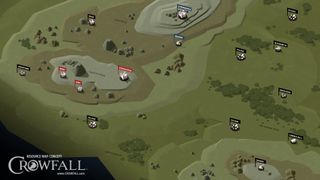
There are a lot of fun-sounding roles to play here: You have the building game, where players are transporting raw materials from quarries and building fortresses to keep out intruders. Then you have the siege game, where armies gather to kick over those fortresses and attack the Trees (they drop even more Bloodstones when destroyed). And then you have all the little treacherous journeys, where small bands are entrusted to deliver and sacrifice Bloodstones while gangs hiding in the forests try to ambush them.
How well it all works when it's full of players is yet to be seen. Right now, ArtCraft is working on Crowfall’s core systems—what they refer to as the “deck of cards”—which include the basics like character animation and movement, world generation, combat, and skills. To use their metaphor, the campaigns will be the games you can play with that deck of cards, and they may come in all kinds of varieties.
It gives us the ability to make mistakes, and enjoy those mistakes.
Not even these Bloodstone details are finalized, but for as long as Crowfall runs, the rulesets never really will be. Coleman and Walton are excited at the opportunity to iterate. If one campaign doesn’t work, they can tweak it or retire it and try something else. If one class or item is overpowered, the hope is that it’ll become a funny story to tell 10 campaigns later, where the imbalance has long since been corrected. “It gives us the ability to make mistakes, and enjoy those mistakes,” says Coleman, “And have those mistakes come to a natural expiration without having to walk in with a Nerf stick and hit everything.”
I fear that even one three-month campaign with a fatal flaw could turn some players off, even if they know it'll be fixed in the next one, but the impermanence does give ArtCraft the opportunity to analyze player behavior and eventually hone the campaigns into their ideal selves. So if all goes well, Crowfall should only get better, instead of staler, with time. The fallout of mistakes is also contained by a passive training system, à la Eve Online. Exploiting a design flaw isn’t going to let anyone train up faster than anyone else, it may just offset the balance of a specific set of campaigns until it's fixed.
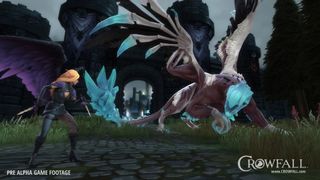
20 questions
As with any MMO, there are a ton more questions to ask. How will crafting work? They say it will be important, and the economy will be truly player-run. How will combat work? The physics model is meant to ensure that it’s not of the ‘standing still clipping through a monster’ variety, and as of now it’ll require some skill with targeting and active dodges. Will there be permadeath? A character can’t be killed off, but there could be a campaign ruleset that gives you only one life before booting you out. Can you play solo? You can try, but it sounds like the fun is meant to come from group PvP warfare, not lone-wolf PvE grinding—and grinding isn't really an issue anyway with the passive skill training.
And then there’s that one big question: will it be free-to-play? No. A lot hasn't been nailed down, but Coleman and Walton seem certain about this: it will be pay-to-play, with an optional subscription. It isn’t worked out exactly what the subscription will do, but one idea is that it will allow you to passively train all three of your characters simultaneously rather than one at a time. It will also be possible to trade or gift subscriptions to other players.
Crowfall will be crowdfunded, though, and its Kickstarter campaign is running now—though they've already spent money setting up the company and prototype. That funding came from themselves, "friends and family," and "strategic investors," and it sounds possible that additional funding may be sought. "If it doesn't work—if the Kickstarter campaign just isn't that interesting to a lot of people—we have a background of raising money for games," says Coleman. "But we really don't want to, because the inevitable pressure to widen the funnel will be there if we start taking money from other people. We'll be right back in that same situation where somebody will want a spreadsheet and say, 'Well these numbers look good, but they could look really great if you started to change the design to do X,Y, and Z.'"
MMOs are expensive, though, and I think Coleman and Walton are a little mad for attempting one at all, but as our conversation turns toward traditional publishing and that one MMO, it’s pretty apparent why so many experienced designers want to build MMOs outside the traditional publisher/developer system.
Talking about the days when World of Warcraft took off, Coleman reminisces: “If you were to go into a pitch meeting and say, ‘Hey, I want to make an MMO,’ then the standard question they ask you is, ‘Well, how are you going to do compared to WoW? What percentage of the WoW playerbase are you going to have?’ And if you’re having to pitch WoW-like numbers, the best way to make it sound like you can achieve that is to borrow heavily, or clone.”
We don’t need to be WoW. We don’t even need to be a tiny part of WoW.
“We don’t want to take anything away from WoW,” adds Walton. “WoW’s awesome for what it is—the very first time I played it in beta I went ‘Oh shit, this is going to change the whole thing.’ But it doesn’t mean there’s not other niches. We don’t need to be WoW. We don’t even need to be a tiny part of WoW. We’re looking for customers who want the kind of thing we’re building. We don’t expect or actually want 50% of the WoW players to come. All they would do is torture us to change the game to make it like WoW and we would not like that.”
“It would take everything that’s special about our game and strip it away,” says Coleman. “It’s a great game, but it doesn’t have to be the only game.”

I appreciate the sentiment, because I’m also tired of games that say they definitely aren’t going to be anything like WoW but then are actually quite a bit like WoW. But all of this interesting talk is still just interesting talk, and I have to be a little skeptical of any crowdfunded MMO. I am encouraged by the creators’ experience and their prototype, though. I saw a game with animations and worlds and physics and combat, as well as some basic voxel building tools, so they're not going into this Kickstarter campaign with only dreams and concept art.
Still, we’ve all started to learn pretty well how expensive and long a saga MMO development is. Even if Crowfall exceeds its Kickstater goal or acquires additional funding, I'm curious to see how long it takes to get this deck of cards ready for a deal. (Sometime before Star Citizen releases, maybe?)

Tyler grew up in Silicon Valley during the '80s and '90s, playing games like Zork and Arkanoid on early PCs. He was later captivated by Myst, SimCity, Civilization, Command & Conquer, all the shooters they call "boomer shooters" now, and PS1 classic Bushido Blade (that's right: he had Bleem!). Tyler joined PC Gamer in 2011, and today he's focused on the site's news coverage. His hobbies include amateur boxing and adding to his 1,200-plus hours in Rocket League.
Most Popular





